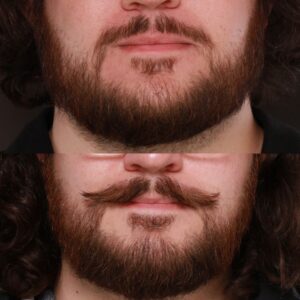UFP Hair Restoration offers some of the most advanced techniques and options in facial hair restoration for mustaches, beards, eyebrows, and sideburns. Facial hair is an important component that can influence one’s appearance and accentuates facial features.
Loss or thinning of facial hair can caused by several things. Genetic factors or hormonal imbalances can play a big part. Other causes could be a result from over tweezing, laser hair treatments or injuries. Facial hair can be restored to the beard, eyebrows, mustache, and sideburns.
Hair Restoration For The Face and Eyebrows
How Does a Facial Hair Transplant Work?
Hair Transplant was once limited to the scalp area, but with time and advanced technology, facial hair transplant is now possible. It is very similar to a traditional hair transplant as the hair is taken from the back of the scalp and placed into the desired facial areas. Dr. Thompson, Dr. Henstrom, & Dr. Manning along with our experienced hair team harvest the grafts and meticulously place each graft in the directions of hair growth so that they are natural and blend in with the surrounding hairs.
FUE and FUT surgery is available for facial hair restoration and will be discussed at your consultation to determine which method is right for you.
Many men like the appearance of facial hair. Some men are unable to grow facial hair or have patches of hair that will not grow in due to various reasons. Fortunately, hair transplant surgery is available to give men the appearance they desire.
The eyebrows are an important part of facial symmetry and greatly contribute to the aesthetic appearance of men and women. Eyebrows frame the eyes, typically the first facial feature others notice. It’s no wonder over-plucking or waxing can leave many feeling self-conscious about their facial appearance, despite their best efforts to draw or tattoo eyebrows on. The results of such techniques are typically unnatural and/or short lasting. Eyebrow Restoration can be a permanent process to restore a brow or enhance one's brow to give an individual the look they have always desired.
Sideburns are an area that can create a stylish statement as well as enhancing facial symmetry. Whether it be in combination with a nicely trimmed beard or visible when the hair is pulled back into a ponytail for a clean look, this area can be considered for both men and women. Loss of sideburns can also be a cause of genetic issues or cosmetic reasons such as a previous facelift surgery or laser hair removal. Facial hair restoration is available to add or restore hair into the sideburn area.


The UFP Facial Hair Restoration Difference
- 3 Specialized Facial Plastics/Hair Restoration Surgeons
- 2 locations in Northern Utah
- Full, natural appearance
- Cutting edge techniques
- Proven success stories
- Minimal downtime
- Permanent results
- Outstanding local patient care
- Ongoing support
- Trustworthy reputation
Learn More
Contact
Interested in getting hair restoration for your facial hair needs in Salt Lake City, Draper, Layton, Utah and the surrounding areas? Contact UFP Hair Restoration for more information or to schedule an appointment call 801.849.8140 or fill out our contact form here. You can also submit your information and photos through our Virtual Consultation page for a free estimate delivered within 24-48 business hours.